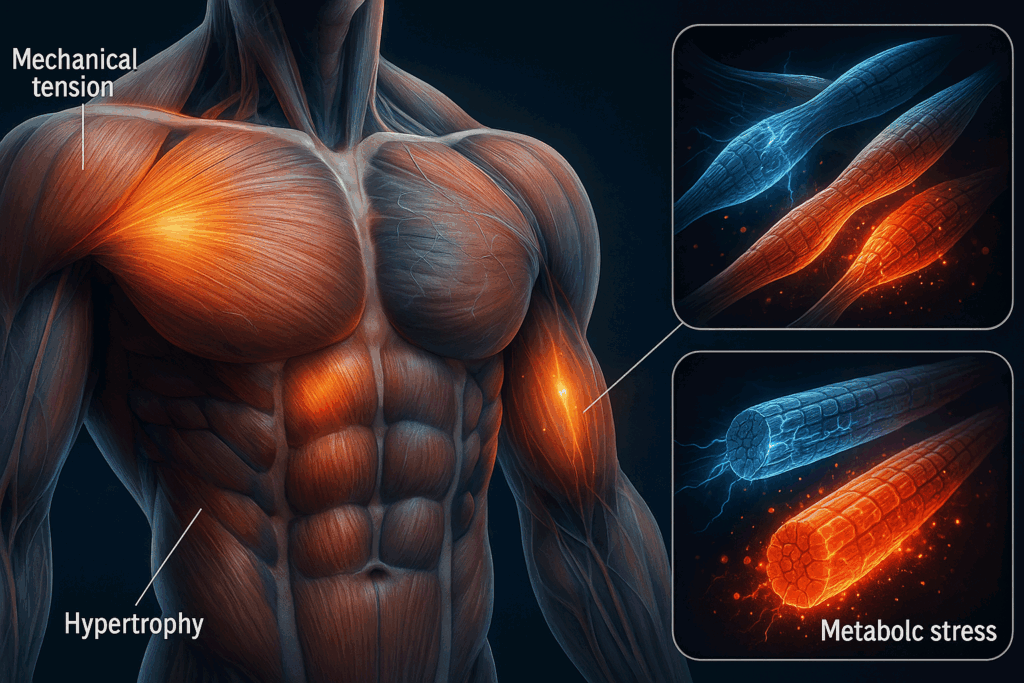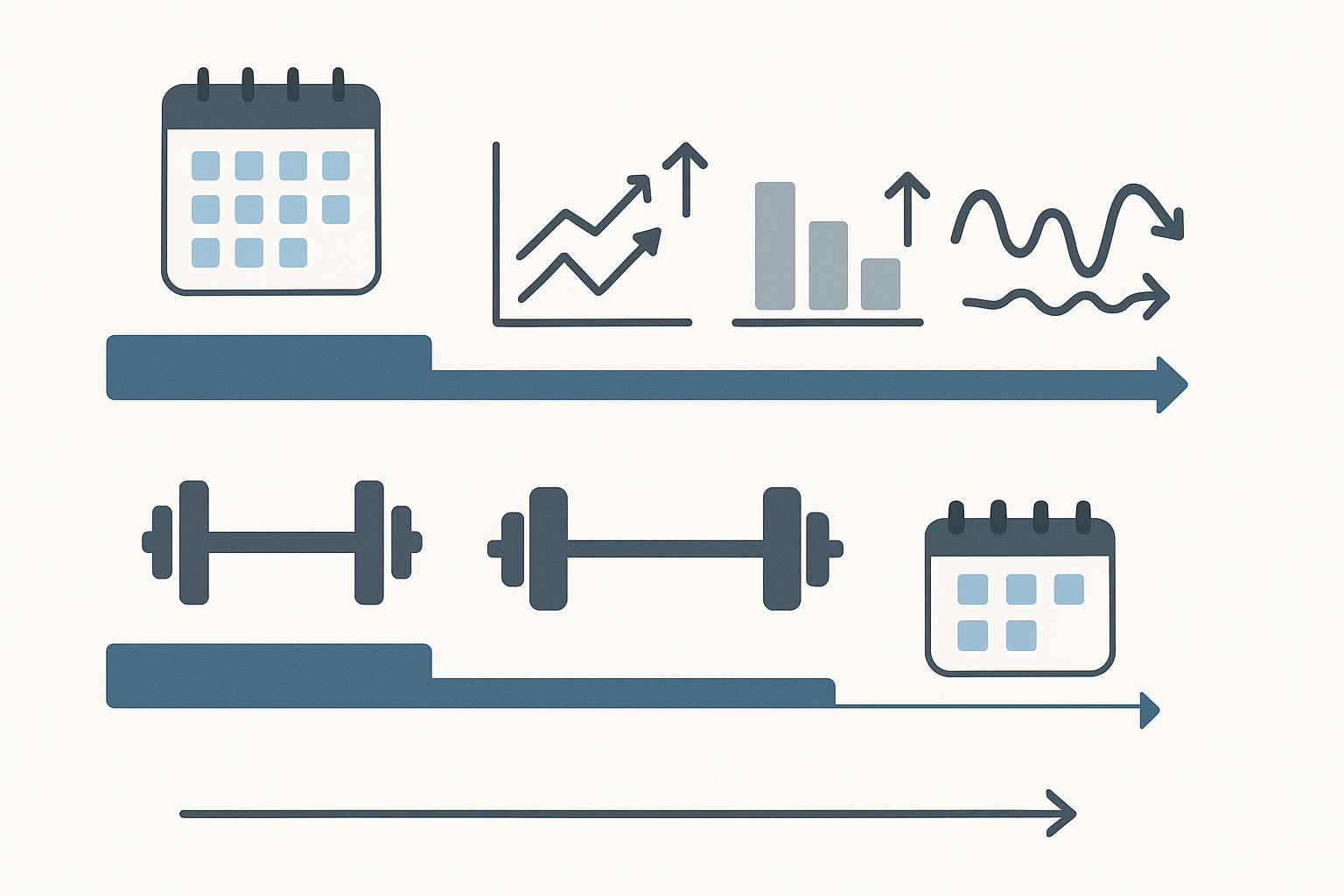In the ever-evolving world of strength and fitness, the pursuit of muscular hypertrophy demands more than basic weightlifting. For those ready to push their bodies beyond intermediate gains, embracing an advanced workout routine becomes not only necessary but transformative. This article delves deep into the science, strategy, and structure behind effective advanced workout schedules, offering insight-rich guidance for maximizing muscle development. As we explore training volume, intensity manipulation, recovery dynamics, and nutritional underpinnings, we anchor our discussion in evidence-based practice that supports sustainable and substantial results.
You may also like: The Ultimate Hypertrophy Workout Program for Building Strength and Size

Understanding the Need for an Advanced Workout Routine
As trainees transition from beginner and intermediate phases, the adaptive stimulus required to foster continued growth must intensify. At this stage, the law of diminishing returns takes hold. The body becomes more efficient, meaning previously sufficient training volumes no longer produce the same results. An advanced workout routine is crafted to circumvent this plateau through strategic complexity, variation, and intensity.
This is where periodization, progressive overload, and specificity become central. Periodization involves planned manipulation of training variables over time, allowing the body to adapt continuously while avoiding overtraining. The emphasis on progressive overload ensures that the body remains under enough stress to trigger adaptation. Meanwhile, specificity ensures that the exercises and techniques used align precisely with hypertrophy goals, targeting muscle fibers in ways tailored to the athlete’s physiology and development stage.
Integrating compound movements with advanced techniques such as supersets, drop sets, and rest-pause sets allows for deeper muscle fiber recruitment. Such methods place unique mechanical and metabolic stressors on the muscles, which is critical for overcoming stagnation. Advanced workout schedules must also incorporate de-load weeks and active recovery to prevent the onset of chronic fatigue and injury.

The Science of Muscle Hypertrophy: What Really Works
Muscle hypertrophy results from a complex interplay of mechanical tension, muscle damage, and metabolic stress. Advanced routines leverage this triad more effectively than basic programs. Mechanical tension, generated through lifting heavy loads and increasing time under tension, is the primary driver of myofibrillar hypertrophy. Muscle damage, caused by eccentric loading and new movement patterns, initiates repair processes that lead to growth. Metabolic stress, on the other hand, results from the accumulation of metabolites like lactate and hydrogen ions during intense training.
Advanced athletes benefit from understanding muscle fiber composition. Type II fibers, which are more susceptible to hypertrophy, respond better to heavy loads and explosive movements. Therefore, targeting these fibers through high-intensity resistance training and plyometrics can yield superior gains.
Moreover, understanding the role of satellite cells and anabolic hormones such as testosterone, IGF-1, and growth hormone can guide advanced lifters in optimizing recovery and muscle synthesis. Strategic use of compound lifts like squats, deadlifts, and presses—coupled with focused isolation work—ensures both central nervous system engagement and localized hypertrophic signaling.
Designing Advanced Workout Schedules for Long-Term Progress
Creating effective advanced workout schedules requires a balance of intensity, volume, and recovery. A popular method is undulating periodization, which varies intensity and volume across days or weeks. For instance, a weekly schedule might involve a heavy day focused on low reps and maximal strength, a moderate day emphasizing hypertrophy with 8-12 reps, and a light day incorporating high reps for metabolic conditioning.
Training frequency must be tailored to individual recovery capacity and lifestyle. For most advanced lifters, training each muscle group twice per week allows for optimal protein synthesis while minimizing the risk of overtraining. Split routines—such as push/pull/legs or upper/lower splits—enable focused training while allowing adequate rest for specific muscle groups.
Exercise selection is another critical component. Compound movements should form the foundation, but variation within these exercises can prevent accommodation. For instance, alternating between back squats, front squats, and Bulgarian split squats introduces new stimuli. Similarly, changing grip widths, bar types, or tempo variations can enhance neural and muscular adaptations.

Advanced Techniques to Maximize Hypertrophy
To unlock new levels of muscle growth, advanced trainees must incorporate specialized training methods. Supersets, which involve performing two exercises back-to-back without rest, increase time under tension and stimulate hypertrophy through cumulative fatigue. Drop sets involve reducing the weight after reaching failure and continuing the set, thereby extending the time muscles spend under tension.
Rest-pause training is another effective method. By incorporating brief pauses within a single set, lifters can surpass momentary fatigue and recruit additional motor units. This is particularly effective for stimulating growth in stubborn muscle groups. Additionally, techniques such as cluster sets—where short rest periods are inserted between repetitions—enable the use of heavier loads without compromising form or safety.
Blood flow restriction (BFR) training, although typically associated with rehabilitation, has shown promise for hypertrophy at lower loads. By restricting venous return while maintaining arterial flow, BFR increases metabolic stress and hormonal responses, making it an appealing option during deload weeks or when joint stress needs to be minimized.

Periodization and Progress Tracking in Advanced Programs
One of the defining characteristics of an advanced workout routine is meticulous planning. Periodization not only facilitates progressive overload but also mitigates the risk of plateau and injury. Linear periodization, where intensity gradually increases while volume decreases, may still benefit some advanced trainees. However, undulating and block periodization often prove more effective.
Block periodization divides training into macrocycles (annual), mesocycles (monthly), and microcycles (weekly), each with specific goals such as hypertrophy, strength, or power. Within these blocks, strategic deloading ensures recovery and long-term progress. Tracking progress through metrics like volume load (sets x reps x weight), PRs (personal records), and body composition analysis enables data-driven adjustments.
Additionally, subjective metrics such as sleep quality, mood, and perceived exertion can provide valuable insights. Recovery capacity varies widely among individuals and is influenced by lifestyle, age, nutrition, and stress. Thus, an advanced routine must remain adaptable, with built-in flexibility to accommodate fluctuations in readiness and energy levels.

Nutrition Strategies to Support an Advanced Workout Routine
Muscle growth is not forged in the gym alone. Nutritional strategies are essential to supporting the demands of intense training. Protein intake remains the cornerstone, with 1.6 to 2.2 grams of protein per kilogram of body weight per day being optimal for hypertrophy. Distribution of protein evenly across meals, with a particular emphasis on post-workout consumption, ensures a steady supply of amino acids for muscle repair and synthesis.
Carbohydrates, often maligned, are vital for energy production, glycogen replenishment, and insulin-mediated nutrient delivery. Advanced athletes benefit from timing carbohydrate intake around training sessions, using high-GI sources post-workout to enhance recovery. Fats, though not a direct fuel source for training, support hormonal health and cellular function. Ensuring a balanced intake of omega-3 and omega-6 fatty acids contributes to an anti-inflammatory environment conducive to recovery.
Micronutrients such as magnesium, zinc, vitamin D, and B-complex vitamins play supporting roles in muscle function, energy metabolism, and nervous system health. Hydration, often overlooked, affects performance and recovery. Advanced lifters should aim for 3-4 liters of water daily, adjusting for training intensity and climate.
Sleep, Recovery, and Lifestyle Integration
Without adequate recovery, the most sophisticated training plans will falter. Sleep, as the primary recovery modality, must be prioritized. During deep sleep stages, growth hormone peaks, and protein synthesis increases. Aiming for 7 to 9 hours of quality sleep per night is non-negotiable for those pursuing maximal gains.
Recovery also encompasses active rest, such as light cardio, yoga, or mobility work. These activities enhance circulation, reduce muscle soreness, and support mental clarity. Stress management, too, is integral. Chronic stress elevates cortisol levels, which can impair recovery and muscle growth. Incorporating mindfulness, deep breathing, and periodic social disconnection can mitigate these effects.
Advanced athletes must also consider lifestyle factors like alcohol consumption, screen time, and social rhythms. While occasional indulgences are acceptable, consistency in healthy habits underpins physical progress. A sustainable approach—one that integrates training, nutrition, and recovery into a balanced lifestyle—is the hallmark of long-term success.
Common Mistakes in Advanced Training and How to Avoid Them
Even seasoned lifters fall prey to pitfalls that derail progress. One common error is training to failure too frequently. While reaching muscular failure has a place, chronic overreliance can lead to central nervous system fatigue and compromised recovery. Instead, incorporating failure strategically within mesocycles—followed by deloading—preserves performance while maximizing adaptation.
Another mistake is program hopping—switching routines before completing a full cycle. Advanced workout schedules are designed with progression in mind. Abandoning a program prematurely prevents accurate tracking and undermines results. Commitment to a structured plan, with scheduled evaluations, allows for meaningful adjustments rather than reactive changes.
Neglecting recovery and mobility is also common. As strength and muscle mass increase, so too does the risk of injury. Regular mobility work, proper warm-ups, and adherence to recovery protocols are non-negotiable. Ignoring signs of overtraining—such as persistent fatigue, mood disturbances, or declining performance—can lead to injury and regression.

Building Mental Resilience Through Advanced Training
Physical strength often mirrors mental fortitude. Advanced routines test not only the body but the psyche. Commitment to demanding schedules, pushing through plateaus, and navigating setbacks all cultivate discipline. Setting long-term goals, breaking them into actionable milestones, and celebrating small victories enhances motivation and adherence.
Visualization techniques and mental rehearsal can improve focus and performance. By mentally walking through a lift or workout before execution, lifters can reinforce neural pathways and boost confidence. Journaling workouts, tracking emotions, and reflecting on challenges build self-awareness and accountability.
Moreover, finding community—whether through training partners, online forums, or coaching—provides support and perspective. Shared experiences normalize struggle and reinforce perseverance. The journey to elite performance is seldom linear, but the resilience forged through advanced training transcends the gym, enriching broader life pursuits.
Revisiting Advanced Workout Schedules: Adaptation and Innovation
As the body adapts, so too must the routine. Innovation within advanced workout schedules is essential for continued progress. Incorporating novel stimuli—such as resistance bands, suspension training, or unconventional implements like sandbags—can challenge stability, coordination, and motor control.
Rotating training emphases—from hypertrophy to strength to power—broadens physiological adaptations. For instance, an athlete may cycle through an eight-week hypertrophy block, followed by a six-week strength phase and a four-week power-focused phase. This approach not only prevents stagnation but also enhances performance across various domains.
Reassessing goals regularly ensures alignment with training. Whether preparing for competition, addressing imbalances, or pursuing aesthetic refinement, tailoring the program to current priorities keeps motivation high and results consistent. Advanced training is both art and science—requiring creativity, intuition, and precision.
The Role of Supplementation in Supporting Advanced Workouts
While whole foods should remain the foundation, certain supplements can complement an advanced workout routine. Creatine monohydrate, extensively researched, enhances phosphocreatine stores, improving high-intensity performance and increasing lean mass. Whey protein, due to its high leucine content and rapid absorption, supports post-workout muscle protein synthesis.
Branched-chain amino acids (BCAAs), while controversial, may benefit individuals training fasted or on low-protein diets. Beta-alanine, by buffering hydrogen ions, can delay fatigue during high-rep training. Caffeine, used judiciously, enhances alertness, power output, and endurance.
However, reliance on supplements should never substitute for dietary adequacy or recovery practices. Moreover, sourcing high-quality, third-party tested products ensures safety and efficacy. Consulting with a qualified nutritionist or sports dietitian can further individualize supplementation protocols.
FAQ: Insights and Expert Advice on Building and Optimizing an Advanced Workout Routine
How can I tailor an advanced workout routine to avoid performance plateaus?
Performance plateaus are common among experienced athletes who follow static programs for extended periods. To overcome this, integrate periodization techniques into your advanced workout routine, cycling between hypertrophy, strength, and power phases every 4–6 weeks. Varying intensity, volume, and rest intervals ensures that your neuromuscular system is continually challenged. Introducing movement variations, tempo changes, and contrast training (e.g., combining heavy lifts with explosive plyometrics) can reignite progress. Monitoring recovery markers such as HRV (heart rate variability) also helps to customize your workload in real time, preventing overtraining while optimizing gains.
What are the psychological factors that support long-term commitment to advanced workout schedules?
Commitment to advanced workout schedules requires more than physical effort—it hinges heavily on mental resilience. Psychological periodization, which includes planned deload weeks for mental as well as physical recovery, helps sustain motivation over the long term. Setting mastery-based goals, rather than purely outcome-based goals like aesthetics, fosters intrinsic motivation. Visualization techniques and mindfulness practices can improve focus, reduce performance anxiety, and make high-volume training more sustainable. Community support, whether virtual or in-person, also significantly boosts adherence through accountability and shared experiences.
How can advanced workout schedules be adapted for aging athletes?
As athletes age, recovery capacity, joint integrity, and hormonal responses change—necessitating smarter, not harder, training. Advanced workout schedules for older populations should emphasize mobility, joint stabilization, and controlled eccentric loading to maintain muscle mass and function. Integrating more active recovery days, including modalities like swimming or yoga, helps preserve joint health and flexibility. Strategic supplementation, such as increased protein intake or collagen, may support recovery. Importantly, regular reassessments of performance markers ensure that the program evolves with the athlete’s changing physiology.
What role does nutrition periodization play in optimizing an advanced workout routine?
Nutrition periodization aligns your dietary strategy with specific training cycles, amplifying the results of an advanced workout routine. During hypertrophy phases, a calorie surplus rich in complex carbohydrates and lean protein supports muscle growth. Conversely, during cutting or conditioning phases, macronutrient manipulation—especially carb cycling—can preserve lean mass while promoting fat loss. Strategic timing of nutrients, such as post-workout leucine-rich meals, enhances muscle protein synthesis. Functional foods like beetroot juice or tart cherry concentrate can further enhance performance and recovery. The key lies in syncing your fuel with your fitness focus.
How does sleep quality influence the effectiveness of advanced workout schedules?
High-performance training demands high-quality recovery—and sleep is the most potent form of recovery. Poor sleep reduces growth hormone secretion, impairs muscle repair, and increases cortisol, which hinders hypertrophy. For those on intense advanced workout schedules, sleep hygiene should be treated with the same seriousness as training. This includes establishing consistent sleep-wake times, minimizing screen exposure before bed, and optimizing sleep environments for temperature and noise. In some cases, wearable sleep trackers can offer insights into REM and deep sleep percentages, helping athletes identify patterns that may undermine their training progress.
How can data-driven tools and wearables elevate an advanced workout routine?
Incorporating wearable tech into your advanced workout routine offers real-time biofeedback, allowing for immediate and precise adjustments. Devices that track heart rate variability, sleep stages, and movement patterns can guide your recovery and volume adjustments with clinical accuracy. Apps with AI-driven analytics can suggest workout modifications based on performance trends or detected fatigue. Over time, this data helps create highly personalized programming that adapts dynamically to your physiology. The goal isn’t just to train harder—but to train smarter, with feedback loops replacing guesswork.
How can you optimize an advanced workout routine for hybrid athletes balancing strength and endurance?
Hybrid athletes—those balancing strength and endurance—must walk a fine line between conflicting adaptations. An effective advanced workout routine for this group involves careful structuring of concurrent training sessions. For example, strength work should be prioritized earlier in the day or week when neuromuscular freshness is highest, while endurance sessions can be placed post-lift or on alternate days. Fueling strategies must accommodate dual demands: higher carbs around endurance sessions and protein-timing around lifts. Strategic rest, particularly between modalities, ensures that neither system is compromised. Monitoring inflammatory markers can also help fine-tune recovery needs.
Why is microcycle variation essential in advanced workout schedules?
While macrocycles set the long-term tone, it’s the weekly microcycles that determine consistency and adaptability in advanced workout schedules. Without variation at the micro level, overuse injuries and neuromuscular burnout are common. Introducing weekly undulating periodization—where volume and intensity fluctuate every few days—keeps the stimulus novel. Recovery-enhancing tactics like contrast baths or myofascial release sessions are often more effective when scheduled within these microcycles. By weaving in variability and active recovery, athletes sustain momentum without stagnation or burnout.
How do social and environmental factors influence success with an advanced workout routine?
Beyond physiology and programming, environment and social structures dramatically shape the sustainability of an advanced workout routine. Training in facilities that foster discipline—whether through expert coaching or high-performing peers—often improves consistency and effort. Environmental cues like having gear pre-set or visual reminders can increase workout adherence. Social validation from group challenges, leaderboards, or sharing progress on digital platforms adds a gamified element that reinforces behavior. These factors aren’t merely peripheral; they form the scaffolding that supports long-term excellence in training.
What emerging technologies are shaping the future of advanced workout schedules?
The future of advanced workout schedules lies at the intersection of biotechnology, AI, and personalized medicine. Genomic testing is already beginning to inform training tolerance and recovery profiles, enabling hyper-personalized regimens. AI coaches analyze performance trends to recommend training shifts before plateaus or injuries occur. VR-based training environments are being used to simulate competition intensity, enhancing mental conditioning. Additionally, blood biomarker services now allow athletes to monitor inflammation, hormonal balance, and nutrient status in real time. These innovations promise a future where advanced workout schedules are no longer generalized, but biologically tailored to each athlete’s evolving needs.
Conclusion: Advancing Beyond Limits with Strategic Training
Unlocking powerful gains with an advanced workout routine requires more than just heavier weights or longer sessions. It demands intention, strategy, and a deep understanding of the body’s adaptive mechanisms. As the complexity of training increases, so too must one’s commitment to recovery, nutrition, and mental resilience. By mastering advanced workout schedules, incorporating scientific principles, and embracing lifelong learning, individuals can continue to build muscle, strength, and confidence well beyond the beginner plateau.
In this pursuit, consistency reigns supreme. When aligned with expert-level planning, recovery, and nutrition, even the most ambitious muscle-building goals become attainable. Whether driven by performance, physique, or personal fulfillment, the advanced trainee finds in every rep not only strength but also self-mastery—an enduring reward of the journey itself.
Further Reading:
Unleash Your Full Potential: Advanced Workout Plan With Tips for Peak Performance
Workout Routines for Men: The Ultimate Guide
The Full Body Workout Routine: 2, 3, And 4-Day Split (Programs Included)





